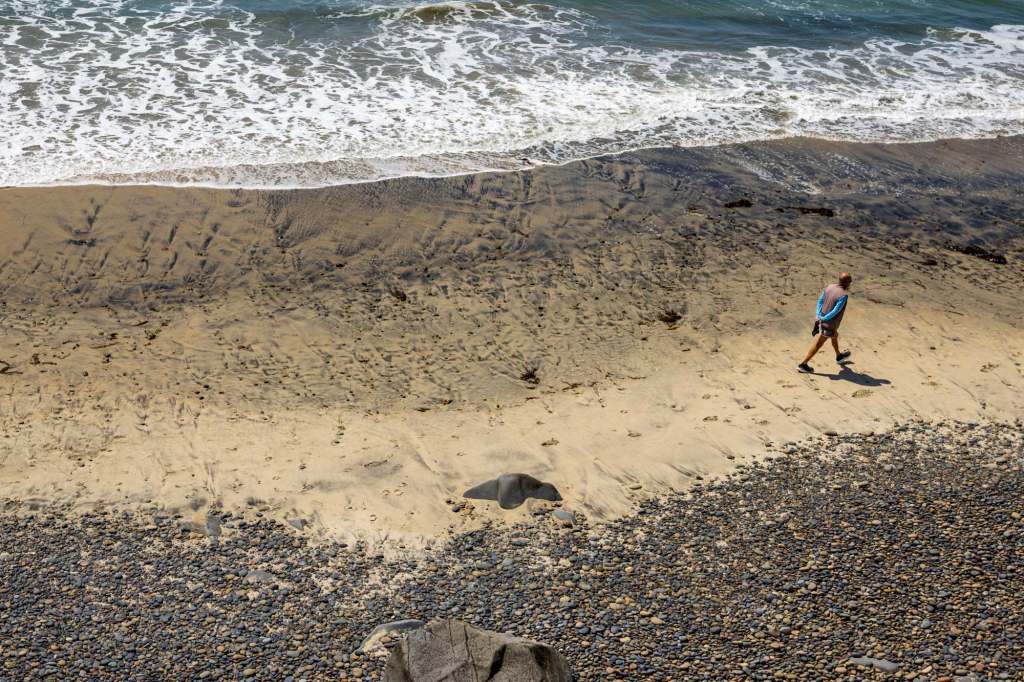
San Diego County’s next regional beach restoration project will be its largest yet, delivering three times the sand previously pumped onto the coastline and at 10 times the cost, planning officials said.
“The time is right to do another regional sand project,” said Keith Greer, deputy director of regional planning at the San Diego Association of Governments, the lead agency for the project.
In 2001, the agency spread a total of 2.1 million cubic yards of sand at 12 different spots along the eroding shoreline from Oceanside to Imperial Beach at a cost of $18 million. A smaller project in 2012 generated about 1.5 million cubic yards for $26 million. State and federal grants paid for most of both projects.
Planning for a third regional sand replenishment began almost two years ago. Two Orange County cities — San Clemente and Dana Point — have joined the project for the first time, along with all of San Diego County’s coastal cities.
This time the collaborative effort is expected to place about 5.8 million cubic yards of sand on 15 sites in San Diego County and three in Orange County. The cost also will go up, to about $260 million, most of which again would have to be covered by state and federal grants.

Studies show the expense is justified, SANDAG officials said Thursday in a presentation to the agency’s Shoreline Preservation Working Group of elected officials from the coastal and bayfront cities, the county, and representatives of the U.S. Navy and the Port of San Diego.
Beaches in San Diego County alone are expected to generate $1.6 billion in revenue over the next 10 years in things such as hotel stays, conventions, tourism and recreational spending, according to one estimate.
“There is a need to maintain San Diego’s beaches to sustain its economy,” said Courtney Becker, a SANDAG associate regional planner.
Oceanside, where the southern two-thirds of the city’s coastline has eroded to bare rocks, will get the largest single share of the sand — about 1 million cubic yards — almost four times the volume obtained from the annual harbor dredging completed in 2024.
Carlsbad would get 240,000 cubic yards for its northern beaches and 300,000 for its more eroded southern beaches. Farther down the coast, deposits of 105,000 to 300,000 cubic yards each are proposed at the mouth of Batiquitos Lagoon, Leucadia, Moonlight Beach and Cardiff in Encinitas, also at Solana Beach and Del Mar.
Torrey Pines, Tourmaline Beach and Mission Beach in San Diego, Coronado Shores, Glorietta Bay, and Imperial Beach also would get sand.
In Orange County, San Clemente State Beach can expect 800,000 cubic yards, San Clemente’s North Beach would get 250,000 and Dana Point would get 500,000 under the proposal.
The agency is studying about six potential sites in the ocean just outside the surf zone that could provide the sand, including some that were used for the previous regional replenishments.
A feasibility study for the project is nearing completion and should be released to the public in July, Becker said. After that a second phase will begin, engineering and environmental work that is expected to cost about $3 million and is so far unfunded.

The third and final phase is construction, which could only take place once more funding becomes available.
SANDAG recently applied for a $5.2 million state grant that would help pay for the project, she said. Acceptance of the grant requires a 15% local match.
“We recognize that local jurisdictions can not pay for this alone,” Becker said. “This needs to be a local, state and federal share.”
Ideally the regional replenishment would be done every 10 years, she said. Most of the sand from the 2012 placement has long washed away, leaving much of the county’s coastline narrow and rocky.
Past projects show that less sand applied more frequently, and in the right places, does a better job of protecting the coastline than long waits between big deposits, said Reinhard Flick, and oceanographer with Scripps Institution of Oceanography.
“That should be taken into account,” said Flick, who has studied waves, tides, sea levels and coastal erosion since 1969. “This is crucially important, that we use the best available science.”
All of Southern California’s coastal cities share the problem of beach erosion, the result of widespread development that has stopped the natural supply of sand from rivers and crumbling seaside bluffs. Sea-level rise and more frequent, powerful storms shrink the shoreline further.

Encinitas, Solana Beach and San Clemente all received the first fruits of major U.S. Army Corps of Engineers replenishment projects that, after decades of planning, began last year and are expected to continue periodically for 50 years.
Oceanside has been planning its own sand replenishment and retention project, called Re:Beach for more than two years and is in final design and engineering stages.
“We need to not just place sand, but to permanently change the shape of the coastline to keep that sand,” Jayme Timberlake, Oceanside’s coastal zone administrator, told the shoreline working group.
The proposal includes the creation of two artificial headlands or small promontories extending out on the beach to hold the sand in place. Also, the city intends to build a chevron-shaped artificial reef in the water to deflect some of the incoming wave energy.
Like the regional projects, the Oceanside effort needs grant funding and approvals from multiple agencies.
And in Carlsbad, maintenance dredging at the mouth of the Agua Hedionda Lagoon is nearing a finish for the first time in four years. That work began in February and is placing up to 400,000 cubic yards of sand on beaches north and south of Tamarack Avenue.
Originally the Agua Hedionda Lagoon was dredged every few years by the San Diego Gas & Electric Co. to provide seawater to cool its Encina power plant.
Now the job is the responsibility of operators of the Carlsbad desalination plant, which filters seawater from the lagoon and adds it the potable water distributed by the San Diego County Water Authority.
Originally Published:







